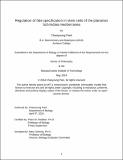Regulation of fate specification in stem cells of the planarian Schmidtea mediterranea
Author(s)
Park, Chanyoung
DownloadThesis PDF (93.97Mb)
Advisor
Reddien, Peter W.
Terms of use
Metadata
Show full item recordAbstract
Regeneration requires mechanisms for producing a wide array of cell types. Neoblasts are stem cells of the planarian Schmidtea mediterranea that undergo fate specification to produce over 125 adult cell types. Fate specification in neoblasts can be regulated through expression of fate-specific transcription factors. We utilize multiplexed error-robust fluorescence in situ hybridization (MERFISH) and whole-mount FISH to characterize fate choice distributions of stem cells within planarians. Our analyses reveal that fate choices are frequently made distant from target tissues and in a highly intermingled manner, with neighboring neoblasts frequently making divergent fate choices for tissues of different location and function. These patterns were present across the animal, and at wounds sites during regeneration. Furthermore, we find that post-mitotic progenitors are able to migrate and be targeted to distant tissue targets, and are able to incorporate into tissues within anatomical regions devoid of neoblasts. We propose that anatomical pattern formation is driven not by the location of fate choice, but through the migratory assortment of post-mitotic progenitors from mixed and spatially distributed fate-specified stem cells.
Animal regeneration requires the ability to accurately replace missing and damaged tissues after injury. The planarian Schmidtea mediterranea is capable of whole-body regeneration, even from small fragments, and is able to regenerate all adult tissues. Regeneration in planarians is driven by a pluripotent population of adult stem cells called neoblasts that gives rise to all adult tissues of the animal. Here we assess regeneration after the specific ablation of body pigment cells and find that loss of pigment cells does not elicit a proliferative neoblast response. Quantification of new cell incorporation dynamics by F-ara-EdU labeling and Smedwi-1 protein perdurance reveals that incorporation of new cells remains unchanged during depigmentation and regeneration. In regenerating animals, a decrease in the magnitude of pigment cell turnover allows for the accumulation and restoration of pigment cell numbers during regeneration. Furthermore, we demonstrate that exposure to UV-B radiation does not accelerate regeneration, indicating that potential loss of pigment cell function is not a trigger to initiate tissue-specific regeneration. Taken together, our data suggests a model in which body pigment cells can regenerate passively without the need for an active proliferative response.
Date issued
2024-05Department
Massachusetts Institute of Technology. Department of BiologyPublisher
Massachusetts Institute of Technology